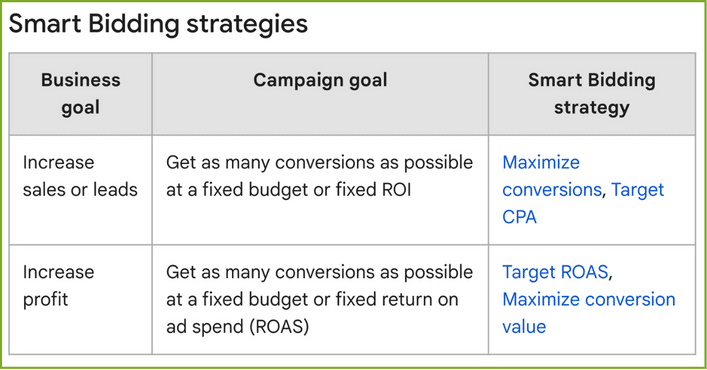Decoding Google Ads Smart Bidding: A Beginner's Guide for SMBs
1. An Introduction to Google Ads Smart Bidding
Google Ads Smart Bidding is an automated bidding system designed to optimise bids in real time, ensuring the highest possible return on investment (ROI) for each ad campaign. This innovative solution leverages machine learning algorithms, factoring in various contextual signals such as device type, location, day and time of week, as well as user behaviour, to create the most efficient and accurate bids.
For SMBs, Smart Bidding presents several benefits that can transform their approach to digital marketing, including:
- Time and Resource Efficiency: With machine learning algorithms handling bid optimisation, SMBs can ultimately save time and resources, enabling them to focus on other aspects of their digital marketing strategy.
- Improved Ad Performance: By factoring in contextual signals, Smart Bidding can place your ads in the most relevant and impactful positions, enhancing overall performance and click-through rates.
- Data-Driven Decision Making: Smart Bidding provides SMBs with access to valuable data and performance insights, allowing for better-informed campaign adjustments and strategic decisions.
2. Types of Smart Bidding Strategies
Google Ads offers several Smart Bidding strategies, each designed to cater to different objectives and desired outcomes:
- Target CPA (Cost per Acquisition): This strategy focuses on acquiring conversions at a set cost per acquisition, making it ideal for optimising campaigns based on customer acquisition costs.
- Target ROAS (Return on Ad Spend): Suited for campaigns aiming to achieve a specific return on ad spend, this strategy helps to maximise conversion value based on a predetermined ROAS percentage.
- Maximise Conversions: If your primary objective is maximising the number of conversions within a given budget, this strategy is an ideal choice.
- Enhanced CPC (Cost per Click): This strategy helps to obtain more conversions by adjusting manual bids for clicks that seem more likely to lead to conversions.

Wondering which Smart Bidding strategy is the best match for your business and campaign goals? Below is a simple table from Google Ads to help you pick the right strategy for what you’re trying to achieve.

3. Setting Up and Implementing Smart Bidding
To create and launch a successful Google Ads campaign employing Smart Bidding, follow this step-by-step process:
- Sign in to your Google Ads account.
- Click on the ‘Campaigns’ tab, followed by ‘+ New Campaign.’
- Choose your desired campaign goal and type, filling in the relevant details and settings.
- In the ‘Bidding’ section, select the recommended Smart Bidding strategy that aligns with your campaign objectives and desired outcomes.
- Complete the remaining steps for creating your ad campaign, such as specifying your ad groups, creating your ads, and defining your keywords.
- Track and monitor the performance of your Smart Bidding strategy throughout the duration of your campaign, making any necessary adjustments to continually optimise results.
4. Best Practices for Optimising Smart Bidding Campaigns
To obtain the optimal results from your Smart Bidding campaigns, consider implementing the following best practices:
- Set Realistic and Data-Driven Targets: When specifying performance targets (such as CPA or ROAS), base these figures on historical data and industry benchmarks. Avoid setting overly ambitious targets that may prove unattainable.
- Provide Sufficient Conversion History: Smart Bidding is at its most accurate and efficient when provided with ample conversion data to inform its machine learning algorithms. Aim to have a minimum of 30 conversions over the last 30 days for enhanced performance.
- Employ Conversion Tracking: For accurate measurements of your campaign’s performance, set up comprehensive conversion tracking to ensure all relevant activity is captured and reported.
- Allow For Learning Periods: During the initial stages of employing Smart Bidding, there will be a learning period where the system adjusts and optimises its bid strategy. Allow for this learning curve and refrain from making major changes during this phase.
- Regularly Review Campaign Performance: Monitor your Smart Bidding campaigns closely, reviewing performance data and making any necessary adjustments for continuous improvement.
5. Key Performance Indicators for Measuring Success
To evaluate the success of your Smart Bidding strategies, it is essential to track and assess a range of key performance indicators (KPIs), such as:
- Click-Through Rate (CTR): Analyse the number of clicks your ads receive in relation to the number of impressions, to gauge ad relevance and effectiveness.
- Conversion Rate: Assess the percentage of users who click your ad and complete a desired action, indicating the success of your campaign.
- Return on Ad Spend (ROAS): Track your ROAS to evaluate the efficiency of your ad spend in relation to conversion value.
- Cost Per Acquisition (CPA): Calculate the cost of each conversion, ensuring it aligns with your predetermined targets and campaign objectives.
Conclusion
Google Ads Smart Bidding presents an innovative, resourceful solution for SMBs to streamline their digital advertising efforts, achieving greater efficiency, relevance, and performance. By understanding the basics, selecting suitable strategies, implementing best practices, and regularly evaluating performance, SMBs can harness the power of Smart Bidding to drive successful campaigns and maximise their return on investment. Embrace the potential of Google Ads Smart Bidding today, and experience the transformative impact it can have on your small-medium business’ digital marketing success.
At Digital Influence, we provide direct and proven digital marketing strategies tailored to your business needs, helping you achieve your marketing goals and maximise your ROI. Contact us today to learn more about how we can help you drive successful campaigns and maximise your ROI with Google Ads Smart Bidding!




